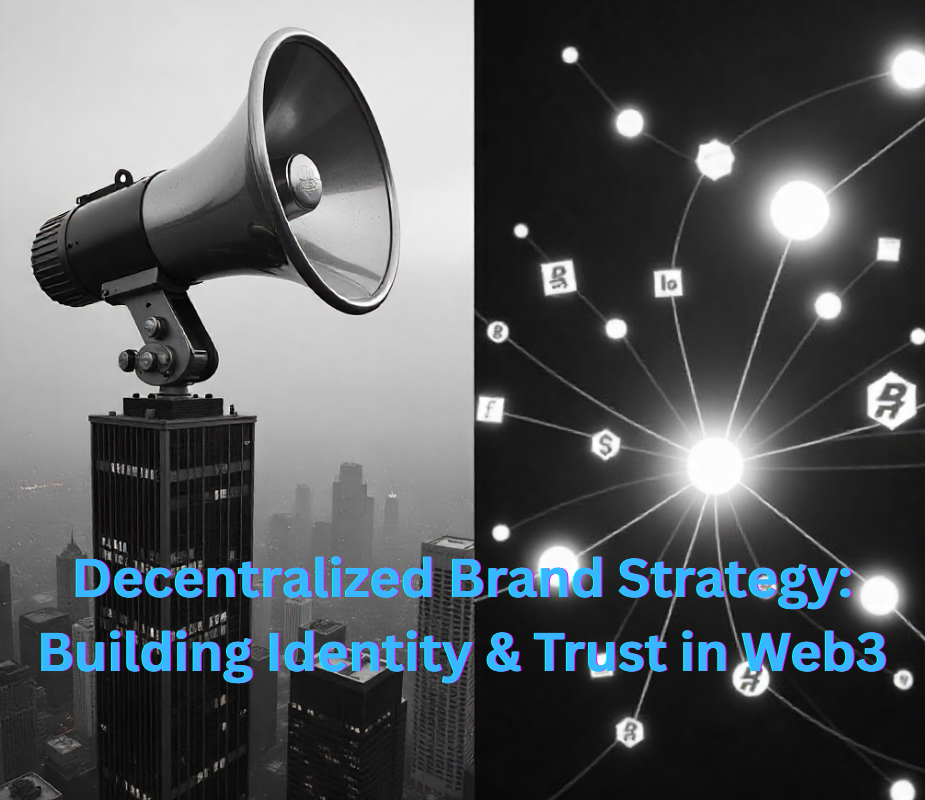
How Web3 transforms branding from top-down control to community-driven ecosystems.
For decades, brand strategy has revolved around centralized control. Corporations dictated their messaging, shaped customer perception, and enforced rigid standards for logos, taglines, and tone. Consistency was king.
But the world has changed. In Web3, audiences are no longer passive consumers. They are token holders, co-creators, and community members with a stake in shaping the story. Control is diffusing away from the boardroom and into the hands of users, who expect transparency, proof of authenticity, and the opportunity to participate.
This isn’t the end of branding—it’s its reinvention. A decentralized brand strategy is not about losing control but about co-creating value, identity, and trust with your community.
Why Traditional Playbooks Don’t Work in Web3
Classic branding thrives on top-down communication. A company decides what it stands for, creates campaigns, and pushes them out to the market. Customers are expected to buy into that vision.
In Web3, this approach falls flat.
- Community is king: Users won’t tolerate one-way messaging. They want to engage, remix, and have their voice count.
- Proof matters: In a trustless ecosystem, authenticity comes from cryptographic verification, not ad campaigns.
- Network effects: Brands that embrace open participation grow faster, while those that cling to centralized playbooks risk alienating users and missing cultural momentum.
Simply put, a Web2-style brand that relies on polished campaigns without community participation risks irrelevance.
What a Decentralized Brand Strategy Looks Like
So, what does it mean to build a brand in a decentralized ecosystem? It’s not just marketing—it’s governance, incentives, and shared storytelling.
- Community-Led Identity
A decentralized brand strategy encourages users to co-create the narrative. Memes, fan art, and rituals aren’t “off-brand”—they are the brand. Think about how Bored Ape owners create their own stories, businesses, and identities around their NFTs. - Tokenized Incentives
Instead of points-based loyalty programs, brands can issue NFTs, tokens, or on-chain badges. These aren’t just gimmicks—they can unlock rewards, governance rights, or exclusive access. - Open Source Brand Assets
Web3-native brands thrive by making their creative assets remixable. Allowing users to adapt logos, artwork, or storylines increases cultural spread and strengthens identity. - Governance & Alignment
DAOs provide a framework for shared decision-making. Communities can vote on campaigns, allocate funds, or shape product direction. Branding becomes a collective process rather than a decree.
Case Studies & Examples
- Bored Ape Yacht Club (BAYC)
BAYC popularized the open-IP model, giving NFT holders full commercial rights to their apes. This allowed a thousand micro-brands—from coffee shops to music labels—to blossom, all reinforcing BAYC’s core identity. - Nike / RTFKT
Nike’s acquisition of RTFKT shows how legacy brands can enter Web3. Rather than controlling every move, Nike allows RTFKT’s community to experiment with NFTs, skins, and metaverse fashion, blending mainstream brand power with decentralized creativity. - Smaller DAOs and communities
Groups like NounsDAO and Friends With Benefits demonstrate how grassroots brand-building works. With no billion-dollar budget, they grow by empowering their members to create, remix, and evangelize the brand in their own way.
Core Pillars of a Decentralized Brand Strategy
- Transparency
Roadmaps, governance decisions, and brand actions are made visible—often on-chain. Trust is earned by showing, not telling. - Participation
Community members don’t just consume content; they create it, vote on it, and share ownership in the outcome. - Incentives
Brands reward meaningful contributions with tokens, NFTs, recognition, or access. Incentives go beyond financial gain to include reputation and belonging. - Interoperability
A decentralized brand doesn’t live in one walled garden. It travels across blockchains, metaverses, and social platforms. Assets and identity must be portable. - Flexibility
Traditional branding obsesses over consistency. Decentralized branding embraces adaptability, encouraging user-generated content and cultural remixing while guiding the narrative at a higher level.
Challenges & Risks
Decentralization isn’t without challenges. Businesses must navigate:
- Loss of message control: When users shape the narrative, brands must learn to influence rather than dictate.
- Legal/IP complexities: Open-source brand assets can blur ownership lines. Companies need clear frameworks to prevent disputes.
- Community misalignment: Without shared purpose, decentralized brands risk fragmentation or takeover by competing interests.
- Sustainability: DAOs and communities can lose momentum without careful stewardship. Hybrid approaches—central guidance with decentralized execution—often work best.
How Businesses Can Transition
Moving from centralized branding to decentralized strategy doesn’t happen overnight. But companies can start small and scale up.
- Start with Listening
Before launching a DAO or token, understand your community. Where are they already gathering? What narratives are they creating around your product? - Experiment with Token-Gated Access
Try small-scale pilots: NFT-based memberships, token rewards for early adopters, or gated events. - Build a Participation Playbook
Define how the community can contribute. What earns rewards? How do governance votes work? Where does decision-making sit between the brand team and the community? - Leverage Web3 Platforms
Build where your audience already spends time—Discord, Farcaster, Lens, and DAO tooling platforms. Align your brand infrastructure with the culture of Web3. - Create Hybrid Models
Most successful brands combine central oversight with decentralized participation. The brand team sets guardrails, but the community drives culture and execution.
Final Thoughts
Branding in Web3 isn’t about logos, slogans, or polished campaigns. It’s about building living ecosystems that evolve through community ownership, participation, and shared identity.
A decentralized brand strategy doesn’t abandon control—it redefines it. Control shifts from rigid messaging to guiding principles, from top-down dictates to community-powered momentum.
The future belongs to brands that embrace this shift. Those who resist will struggle for relevance, while those who experiment with openness, incentives, and community governance will build brands that are trusted, resilient, and unstoppable.
At Argot, we help businesses design and implement decentralized brand strategies that connect with communities, create lasting trust, and unlock the full potential of Web3. The question is not whether your brand will decentralize—but how and when.
TABLE OF CONTENT


